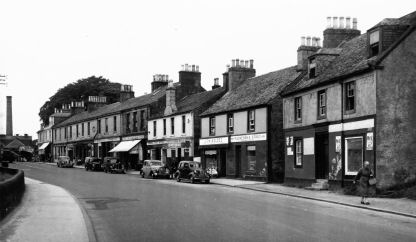BONHILL PAGE 4
The growth in the riverside factories and in the population of both Alexandria and Bonhill, had by the late 1820's outstripped the capacity and suitability of the Ferry service. Not only was there
a risk of accidents when the water was high - a 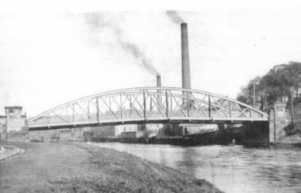 works manager and his sons were drowned in a ferry accident - there were long delays in crossing when the works came out.
works manager and his sons were drowned in a ferry accident - there were long delays in crossing when the works came out.
There were petitions to build a bridge but the ferry owner, Smollett, declined. Smollett from the outset had a conflict of interest in this matter. He not only owned the ferry, but he also served from time to time as a County Commissioner. In the days before local government democracy, Commissioners were members of the local gentry who were appointed by central government to run local government in their area. Specifically, at the time that the matter was under consideration he was a Roads Trustee.
In 1834 a new Turnpike Act was passed under the terms of which a bridge could have been built across the Leven and Smollett would have received the equivalent of about 5 years fees as compensation for the loss of the ferry. A few months after this Act was passed, Smollett said that he was now happy to replace the ferry with a bridge, but not on the basis of the new Act, but on the basis of the previous one, which in effect allowed him to charge tolls on the new bridge for ever more.
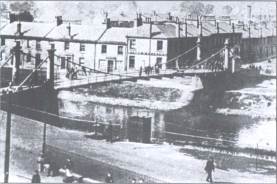 His fellow Road Trustees allowed him
to proceed on the basis of this superseded Act, and, even worse, in 1841 allowed Colquhoun to build Balloch Bridge on the same basis. Graft and corruption in local government was alive and well long
before there was any hint of electing councillors.
His fellow Road Trustees allowed him
to proceed on the basis of this superseded Act, and, even worse, in 1841 allowed Colquhoun to build Balloch Bridge on the same basis. Graft and corruption in local government was alive and well long
before there was any hint of electing councillors.
Bonhill Bridge was duly opened in 1836 and the toll for each crossing was a bawbee, hence the name of the “Bawbee Brig”. This was a considerable tax on people who had to cross the bridge regularly, and caused considerable ill feeling.
There were frequent demonstrations against the toll, many involving violence. Its validity was tested in the courts, but the toll was upheld because the case based on the wrong point of law - the judge knew only too well how it could have succeeded, but said nothing. When the branch railway line was laid into Dalmonach Works in 1860 a separate siding was provided outside the Works gates for the convenience of other customers.
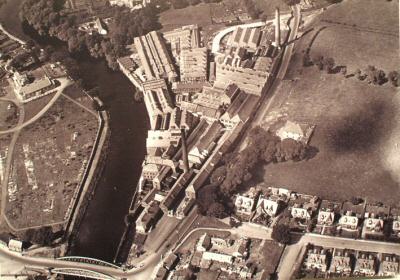
Dalmonach Works
A measure of Smollett's rapacity was that they sued the railway company for the loss of business, and the railway company paid them £100 per annum compensation. One unforeseen aspect of the toll was that it acted as a unifying force across the whole community and many of the Works owners and members of the moneyed classes supported their employees in their efforts to have it removed. The enabling act under which the Tolls should have been immediately abolished was actually passed in 1878, but Smollett (and Colquhoun at Balloch) managed to haggle on for another 17 years.
The bridge tolls were finally removed on 15th May 1895, and a great “Freeing of the Bridges” parade was held round the Vale crossing both Balloch and Bonhill Bridges. However, £30,000 final compensation was paid (the bridge had cost about £5,000 to build). This was in addition to the 59 years of toll income, about 54 of them illegal. Ironically the old suspension bridge only lasted another 3 years being replaced in 1898, and that bridge was itself replaced by the present “Rainbow” bridge in 1987.
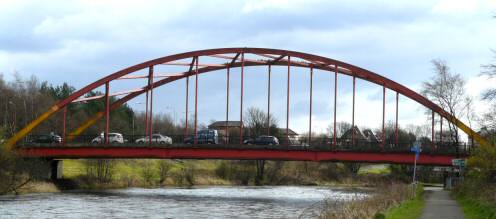
The Rainbow Bridge Opened in 1987
Bonhill was on significant droving routes from the Middle Ages right up until droving died out about 1900. Initially the cattle were heading for the Glasgow market, but from about 1770 onwards, when Falkirk Tryst became the main cattle market in Scotland, Bonhill ford, and the ford at Balloch, were especially busy each autumn. In Bonhill, the land where the old parish church hall was built (now gone) was at one time known as the "dripping grounds". Cattle entered the ford roughly where the bottom of Bank Street lies and crossed, coming out on the sand bar built up by the Burn. They then dripped as they dried on the bank where the church hall was later built.
After crossing the Leven, initially by ford, but after 1836 by the Bridge, the cattle drives had a variety of choices. If they turned left after crossing the Leven, they went past Dalmonach and headed either for the Auchincarroch / Cameron Muir Road, or Balloch / Gartocharn. If they turned right (a very slight right, if they were crossing the ford) they then went left into the Burn, up past the quarry and onto the hillside drove road to Killearn.
An indication of the importance of a village to the droving trade was the presence of a pub called the “Black Bull”. Almost every Scottish droving village had a Black Bull Inn and Bonhill was no exception. A drover from mid-Argyll, Dugald McDougall, recorded his experiences on tape for Eric Cregeen in 1956, when McDougall was 90 years of age. He drove cattle from mid-Argyll to Falkirk Tryst from the mid 1880's almost until the end of the Tryst (it closed in 1901). His last journey was in the late 1890's, and throughout his droving career, his preferred route for crossing the Leven was via Bonhill Bridge and then up Burn Street and onto the hill. From there he headed for the Merkins Farm, at that time owned by the Anderson family, where the cattle rested for the night, before pushing on via Killearn for Larbert and the Tryst.
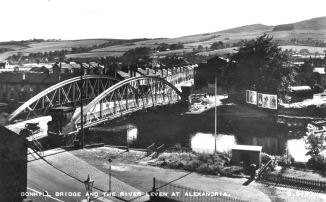
The Old Bridge which replaced the Bawbee Brig.
This was itself replaced in 1987 (Click to Enlarge)
Even before the bridge was opened in 1836, the village had expanded northwards. The engraving of the Wee Field of about 1838 shows that two storey tenement buildings now occupied nearly all of the land on the east side of Main Street, northwards from the Burn to the Bridge. At that time, housing stopped there with only Dalmonach Works and Mount Zion Church to the north, although what became termed the “Dummy's Brae” was also laid out at about this time, leading up to Northfield Farm on the hillside.
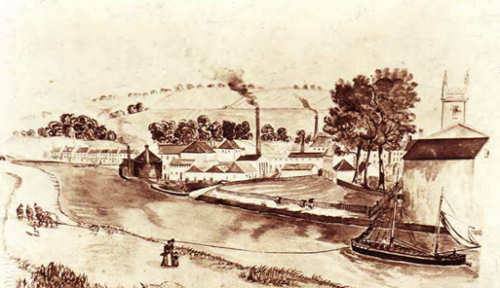
The Factory at the "Wee Field", Bonhill
When the Wee Field was closed down about 1840, it did not lie derelict for long. On part of the site, the first Bank in the Vale was opened in 1842. This was a branch of the Commercial Bank, but was popularly known as “Moir's Bank” after its first agent or manager.
It is said that initially it attracted most of its custom from Alexandria folk with whom its location was popular because it stopped their neighbours from spying on them when they went about their financial business. And, of course, if you had need of banking facilities, the bawbee toll on the Bridge was hardly likely to be a problem. A few years later Moir moved across the road into a building owned by his father-in-law, Nairn of Dalvait House, Balloch a successful businessman and landowner in the area - amongst many other businesses, the family owned Fair View Quarry in Auchincarroch when it was in operation.
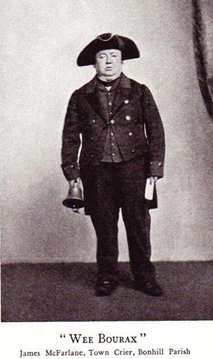 Another sign of Bonhill's growth and increasing status is that from about the middle of the 19th century onwards it employed its own bellman or town crier, James MacFarlane. He is far better known
by his nickname, “Wee Bourax or Bourocks” you can take your pick.
Another sign of Bonhill's growth and increasing status is that from about the middle of the 19th century onwards it employed its own bellman or town crier, James MacFarlane. He is far better known
by his nickname, “Wee Bourax or Bourocks” you can take your pick.
The origin of the first part of his nickname was self-evident since he stood little more than four feet tall. The “Bourax” part is a mystery, although it is well enough recorded that he did not like it. He had been born at Arden about 1817, coming to the Vale as an infant.
The town crier's job seemed ideal for him, and the Oddfellows (a friendly society who had one of the first meeting halls in Alexandria, at the corner of Random Street and John Street) bought him a town crier's uniform to go with the job. There are a number of photographs of him in the uniform.
People obviously took to him and he was provided with various part time jobs, one of which proved unfortunately to
be his undoing. He was selling fish from a horse and cart in Bonhill Main Street in August 1870 when the horse bolted for 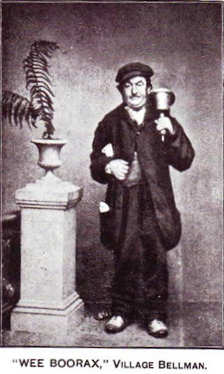 some reason, and crashed the cart into a lamppost outside Bonhill Inn. A postman
who was first on the scene found Wee Bourax lying in the bottom of the cart, dead from a fractured skull. This sad incident was also the Vale's first accurately documented fatal road accident,
although Wee Bourax would surely have been happy to pass up that niche in history.
some reason, and crashed the cart into a lamppost outside Bonhill Inn. A postman
who was first on the scene found Wee Bourax lying in the bottom of the cart, dead from a fractured skull. This sad incident was also the Vale's first accurately documented fatal road accident,
although Wee Bourax would surely have been happy to pass up that niche in history.
When it was built in 1845, Dillichip Cottage, which became the Dillichip Hotel about 1960 and is now part of the Riverside, stood alone as the last house at the southern boundary of Bonhill. However, it was inevitable that the village would creep south as it expanded, and that already had started with the building of the Free Church. Raglan Street, and the houses up to it, were built in the late 1850's and early 1860's. After Dillichip Works was acquired by Orr Ewing in 1866, the Works were considerably expanded and this increased the demand for workers and therefore housing.
One of the first results of this was the building in 1870 by Orr Ewing in Dillichip Loan of what became known as “The Woman's House” or in the vernacular, "The Wumman Hoose". It got its nickname because it was built to accommodate single woman who had come into the area to work in Dillichip. This shows that immigration into Bonhill was still in full swing in the 1870's. Although this was the best-known terrace that was built by Orr Ewing to accommodate incoming employees, it was not the only one. Nor did it continue to be a woman's preserve for very long, but reverted to normal family accommodation by the early 20th century.
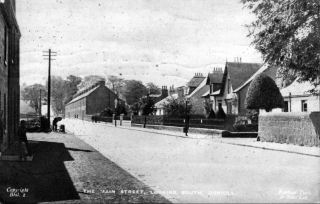
Dillichip Cottage was the last house in Bonhill
before Dillichip Terrace was built (Click to Enlarge)
In the 1950's the Wumman Hoose was taken over in part by a light engineering start-up company, Roberts Engineering. They established in an attic in the Wimmin's House about 1952. To begin with the business was a machine tool design operation for clients such as John Brown Land Boilers. When clients asked them to manufacture some of the tools and components which they designed, they felt duty bound to comply. As luck would have it, an end flat was available and manufacturing was started in it.
Over time as the business grew, a lean-to and then an extension was added, and manufacturing was started in another flat. This was a classic cottage industry with a small number of employees, including a couple who turned out components in the flat next door to the one in which they lived. Both the owners also lived in the Terrace at one time. Eventually, the success of the company required more room and Roberts moved out to a purpose-built unit in Lomond Industrial Estate. There were still a number of people living in the Terrace, but it was scheduled for demolition and was knocked down before the 1970's were out.
About 1880, a new street, George Street, was laid out in Braehead. To begin with, George Street mainly featured detached villas, and it comfortably co-existed with Ladyton Park, although it was built on part of the Park. Ladyton Park was the de facto public park for Bonhill and was the starting point for the great parade, which marked the Freeing of the Bridges in 1895.
It was gradually eaten into by housing and disappeared altogether in the 1920's when the council built a much-needed estate on what remained of it. Access to George Street was via the existing Croft and Campbell Streets which had been built up from much earlier in the 19th century, but which had been cul-de-sacs until George Street was built.
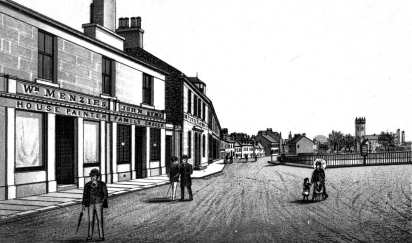
Bonhill Main Street Drawing (Click to Enlarge)
In 1882 the newly formed United Water Committee brought about a major improvement in the living conditions in the whole of the Vale, but particularly Bonhill. This Committee inaugurated a scheme that extracted water from Loch Lomond at Drumkinnon Bay and distributed it throughout the Vale in a network of newly laid pipes. It was eventually replaced in 1909 by the Finlas scheme, which remains the basis of the Vale's water supply to this day.
However the 1882 scheme was particularly beneficial to Bonhill where much of the water had been supplied by springs and wells, which then supplied public pumps and stands by a number of ingenious feeds, but where a large part of the population still used the Burn as both a supply and a drain. One incidental but direct and long lasting benefit was that, almost as soon as the public stopped using Ladyton Springs as a water source in 1882, Alex McDougall moved in and started to produce his lemonade from these Springs. It was made at Ladyton Springs until the late 1980's. No true Vale man, woman or child ever drank any other soft drink, and the world has not been the same since McDougall's lemonade factory closed.
Naturally, as the population grew so did the number of commercial premises that supported them. It was not only shops which opened in Bonhill, although there were an impressive number of them, it was the banks which already have been noted, and medical halls. It is in Bonhill that we find the first references to medical halls in the Vale. These were not only the precursors to chemist shops, but the term was also applied to what we would now call doctors' surgeries. It was to one of them in Main Street that people who were injured in works accidents were taken, so it could be said that they also served as primitive hospitals for much of the 19th century.
Now we rely mostly on photographs to identify the 19th and early 20th century shops that stood in Main Street and the Burn. The earliest of the Main Street photographs probably dates from the late 1850's or early 1860's, since Bonhill Inn, which was built in 1864, does not appear in it. This photograph shows a section of east Main Street from just south of the Bridge to the corner of the Burn and in it are at least eight shops with signage, and in one or two cases awnings open to protect the window displays from the sun. The photos provide more accurate detail of the buildings than the engraving of the Wee Field, which dates from about 1838.
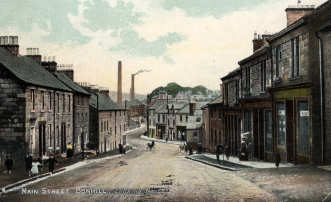
Bonhill Brae with the Cooperative Shops in
the Right Foreground (Click to Enlarge)
Many of these buildings survived until demolished in the road-widening program of the 1980's, and they continued to house shops and pubs right up until their end, although of course with different owners. One long standing shop owner was the Vale of Leven Co-Operative Society which opened four shops with houses above them on the east side of Bonhill Brae between 1871 and 1877.
Early 20th century photos of roughly the same stretch show a couple of pubs, separated by a shop owned by W Edwards of Alexandria - a name that survived until the 1960's. By the 1920's, came shops whose names are still well remembered - Angus the Baker, as well as McArthur's Dairy and Buntine's (a long-lasting Bonhill family) the newsagent. Just as it had at the Fountain, the Liberal Party had premises at a prominent spot close to the Main Street / Burn junction. These premises subsequently became a branch of the Vale FC Supporters Club.
PAGE 1 | PAGE 2 | PAGE 3 | PAGE 5

